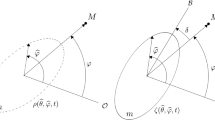Abstract
This report is a review of Darwin’s classical theory of bodily tides in which we present the analytical expressions for the orbital and rotational evolution of the bodies and for the energy dissipation rates due to their tidal interaction. General formulas are given which do not depend on any assumption linking the tidal lags to the frequencies of the corresponding tidal waves (except that equal frequency harmonics are assumed to span equal lags). Emphasis is given to the cases of companions having reached one of the two possible final states: (1) the super-synchronous stationary rotation resulting from the vanishing of the average tidal torque; (2) capture into the 1:1 spin-orbit resonance (true synchronization). In these cases, the energy dissipation is controlled by the tidal harmonic with period equal to the orbital period (instead of the semi-diurnal tide) and the singularity due to the vanishing of the geometric phase lag does not exist. It is also shown that the true synchronization with non-zero eccentricity is only possible if an extra torque exists opposite to the tidal torque. The theory is developed assuming that this additional torque is produced by an equatorial permanent asymmetry in the companion. The results are model-dependent and the theory is developed only to the second degree in eccentricity and inclination (obliquity). It can easily be extended to higher orders, but formal accuracy will not be a real improvement as long as the physics of the processes leading to tidal lags is not better known.
Similar content being viewed by others
References
Alexander M.E.: The weak friction approximation and tidal evolution in close binary systems. Astrophys. Space Sci. 23, 459–510 (1973)
Beutler G.: Methods of Celestial Mechanics, vol. I. Springer, Berlin (2005)
Chandrasekhar S.: Ellipsoidal Figures of Equilibrium, chap. VIII. Yale Univ. Press, New Haven (1969)
Darwin, G.H.: On the precession of a viscous spheroid and on the remote history of the Earth. Philos. Trans. 170, 447–530 (repr. Scientific Papers, Cambridge, vol. II, 1908) (1879).
Darwin, G.H.: On the secular change in the elements of the orbit of a satellite revolving about a tidally distorted planet. Philos. Trans. 171, 713–891 (repr. Scientific Papers, Cambridge, Vol. II, 1908) (1880)
Dobbs-Dixon I., Lin D.N.C., Mardling R.A.: Spin-orbit evolution of short-period planets. Astrophys. J. 610, 464–476 (2004)
Efroimsky M., Lainey V.: Physics of bodily tides in terrestrial planets and the appropriate scales of dynamical evolution. J. Geophys. Res. 112, E12003 (2007)
Efroimsky, M.: Tidal torques. I. A critical review of some techniques. Cel. Mech. Dynam. Astron. (submitted, 2008)
Eggleton P.P., Kiseleva L.G., Hut P.: The equilibrium tide model for tidal friction. Astrophys. J. 499, 853–870 (1998)
Goldreich P.: On the eccentricity of satellite orbits in the solar system. Mon. Not. R. Astron. Soc 126, 257–268 (1963)
Goldreich P.: Final spin states of planets and satellites. Astron. J. 71, 1–7 (1966)
Goldreich P., Soter S.: Q in the solar system. Icarus 5, 375–389 (1966)
Hut P.: Tidal evolution in close binary systems. Astron. Astrophys. 99, 126–140 (1981)
Jeans, J.: Astronomy and Cosmogony, Sec. 215–216 (repr: Dover, New York, 1961). CUP, Cambridge (1929)
Jeffreys H.: The effect of tidal friction on eccentricity and inclination. Mon. Not. R. Astron. Soc 122, 339–343 (1961)
Kaula W.M.: Tidal dissipation by solid friction and the resulting orbital evolution. Rev. Geophys. 3, 661–685 (1964)
Lemaitre A., D’Hoedt S., Rambaux N.: The 3:2 spin-orbit resonant motion of Mercury. Cel. Mech. Dynam. Astron. 95, 213–224 (2006)
Levrard B.: A proof that tidal heating in a synchronous rotation is always larger than in an asymptotic nonsynchronous rotation state. Icarus 193, 641–643 (2008)
Love A.E.H.: A Treatise on the Mathematical Theory of Elasticity. CUP, Cambridge (1927)
MacDonald G.F.: Tidal friction. Rev. Geophys. 2, 467–541 (1964)
Mardling R.A., Lin D.N.C.: On the survival of short-period terrestrial planets. Astrophys. J. 614, 955–959 (2004)
Mignard F.: The evolution of the lunar orbit revisited—I. Moon Planets 20, 301–315 (1979)
Mignard F.: The evolution of the lunar orbit revisited—II. Moon Planets 23, 185–201 (1980)
Munk W.H., MacDonald G.J.F.: The rotation of the Earth. CUP, Cambridge (1960)
Peale S.J., Cassen P., Reynolds R.T.: Tidal dissipation, orbital evolution and the nature of Saturn’s inner satellites. Icarus 43, 65–72 (1980)
Sears W.D., Lunine J.I., Greenberg R.: Equilibrium nonsynchronous rotation of Titan. Icarus 105, 259–262 (1993)
Segatz M., Spohn T., Ross M.N., Schubert G.: Tidal dissipation, surface heat flow and figure of viscoelastic models of Io. Icarus 75, 187–206 (1988)
Tisserand F.: Traité de Mécanique Céleste, tome II, chap VIII. Gauthier-Villars, Paris (1891)
Wahr J.M., Sasao T.: A diurnal resonance in the ocean tide and in the Earth’s load response due to the resonant free core nutation. Geophys. J. Roy. Astr. Soc. 64, 747–765 (1981)
Williams J.G., Turyshev S.G., Boggs D.H., Ratcliff J.T.: Lunar laser ranging science: gravitational physics and lunar interior and geodesy. Adv. Space Res. 37, 67–71 (2006)
Winn J.N., Holman M.J.: Obliquity tides on hot Jupiters. Astrophys. J. Lett. 628, L159–L162 (2005)
Wisdom J.: Spin-orbit secondary resonance dynamics of Enceladus. Astron. J. 128, 484–491 (2004)
Wisdom J.: Tidal dissipation at arbitrary eccentricity and inclination. Icarus 193, 637–640 (2008)
Yoder C.F., Peale S.J.: The tides of Io. Icarus 47, 1–35 (1981)
Zahn J.P.: Tidal friction in close binary stars. Astron. Astrophys. 57, 383–394 (1977)
Author information
Authors and Affiliations
Corresponding author
Additional information
An erratum to this article is available at http://dx.doi.org/10.1007/s10569-009-9198-1.
Rights and permissions
About this article
Cite this article
Ferraz-Mello, S., Rodríguez, A. & Hussmann, H. Tidal friction in close-in satellites and exoplanets: The Darwin theory re-visited. Celest Mech Dyn Astr 101, 171–201 (2008). https://doi.org/10.1007/s10569-008-9133-x
Received:
Revised:
Accepted:
Published:
Issue Date:
DOI: https://doi.org/10.1007/s10569-008-9133-x




